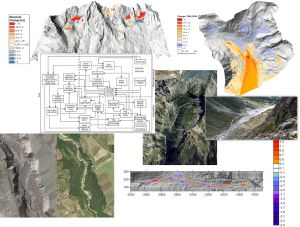
The last 100 years have witnessed serious pressures on mountain environments arising from the combined effects of climate and human forcing. In terms of natural processes, this timescale remains a critical challenge for three reasons.
First, it contains a significant stochastic component that has to be separated from climate or human drivers.
Second, it requires careful experimental design to separate out direct human impacts from natural processes such as climatic variability.
Third, there are important and often overlooked feedbacks in response to climate and human forcing, such as in ecosystem response, which can in turn both accelerate or slow landscape change. In some cases, understanding this ecosystem response is important in its own right so as to secure a sound scientific basis for ecosystem protection and restoration.
We approach these questions through a combination of state of the art technologies, notably in remote sensing, with the study of particular field environments and numerical modelling.
Our work has two main axes. The first aims to obtain a fundamental and mechanistic understanding of the environments that form as glacier retreat, also known as proglacial margins. We are researching their hydrology and geomorphology, how they couple to glaciers and the ecosystems that then form. We currently have two main projects funded by the Swiss National Science Foundation in this research area. We are intensively studying glacier recession, glacial sediment export and the morphodynamics of proglacial forefields using innovative methods to understand how sediment moves under and out of glaciers. We have drilled holes in a large Swiss glacier, Otemma, and are inserting radio-tagged pebbles, whose signature can be seen through the ice, allowing us to track them as they move under the glacier and into the proglacial margin. We are supporting this with environmental seismology to provide continuous records of sediment export out of the glacier and through the proglacial stream. Working with colleagues from the University of Bern we are looking at groundwater in these margins and with colleagues from EPFL and ETHZ what the geomorphology and hydrology of these sorts of systems means for embryonic succession. For examples of our work in this area, you can read about our papers on changing frequency of collapse of Alpine glacier margins, intensification of diurnal discharge cycles in glacier fed stream, subglacial sediment export and the ecosystem engineering of recently deglaciated terrain. Hover and click to access them.
The second axis of our work works over longer time-scales (decadal) and large spatial-scales (10s to 1000s of square km). This axis considers climate change impacts on hillslope erosion processes both inside and beyond the Little Ice Age extent; bedload supply to Alpine rivers under climate change; sediment flux through Alpine river basins; and its relation to lake deposition rates. This component of our work also looks at the direct impacts of human activities, notably hydropower, where we are addressing basic misunderstandings in policy (and even in some laws) about how Alpine hydropower impacts geomorphic systems, and how we can better manage those impacts to improve mountain stream ecosystems. For examples of our work in this area you can read about decadal scale erosion and deposition patterns due to climate warming in Alpine river basins, bedload export from basins undergoing deglaciation and basins already deglaciated, decadal scale changes in river erosion and deposition due to climate change and human impacts, the effects of hydropower on instream insects and how we can better incorporate geomorphology into Alpine hydropower management. In a paper in 2019 we were even able to show how the 2008 financial crisis could be detected in sediment delivery to Lake Geneva because it reduced construction activity and sediment extraction from Alpine streams. Hover and click to access them.
